Study of Water Sorption in Methacryl-Based Polyhedral Oligomeric Silsesquioxane (POSS) Dental Composites Using Molecular Dynamics Simulations
Abstract
:1. Introduction
2. Simulations Details
3. Results and Discussion
4. Conclusions
Author Contributions
Funding
Institutional Review Board Statement
Data Availability Statement
Acknowledgments
Conflicts of Interest
References
- Ozimek, J.; Łukaszewska, I.; Pielichowski, K. Poss and SSQ Materials in Dental Applications: Recent advances and future outlooks. Int. J. Mol. Sci. 2023, 24, 4493. [Google Scholar] [CrossRef] [PubMed]
- Buchwald, Z.; Szołyga, M.; Zwolińska, J.; Marciniec, B.; Voelkel, A. Surface modification of hydroxyapatite with polyhedral oligomeric silsesquioxane. React. Funct. Polym. 2022, 170, 105131. [Google Scholar] [CrossRef]
- Wang, W.; Sun, X.; Huang, L.; Gao, Y.; Ban, J.; Shen, L.; Chen, J. Structure–property relationships in hybrid dental nanocomposite resins containing monofunctional and multifunctional polyhedral oligomeric silsesquioxanes. Int. J. Nanomed. 2014, 9, 841–852. [Google Scholar] [CrossRef] [PubMed]
- Madhuranthakam, C.M.; Pandiyan, S.; Elkamel, A. Molecular simulations of low-shrinkage dental resins containing methacryl-based polyhedral oligomeric Silsesquioxane (POSS). Polymers 2023, 15, 432. [Google Scholar] [CrossRef] [PubMed]
- Ferracane, J.L. Hygroscopic and hydrolytic effects in dental polymer networks. Dent. Mater. 2006, 22, 211–222. [Google Scholar] [CrossRef]
- Yılmaz, M.N.; Gul, P. Susceptibility to discoloration of dental restorative materials containing dimethacrylate resin after bleaching. Odontology 2022, 111, 376–386. [Google Scholar] [CrossRef]
- Spencer, P.; Ye, Q.; Park, J.; Topp, E.M.; Misra, A.; Marangos, O.; Wang, Y.; Bohaty, B.S.; Singh, V.; Sene, F.; et al. Adhesive/dentin interface: The weak link in the composite restoration. Ann. Biomed. Eng. 2010, 38, 1989–2003. [Google Scholar] [CrossRef]
- Sideridou, I. Study of water sorption, solubility and modulus of elasticity of light-cured dimethacrylate-based dental resins. Biomaterials 2003, 24, 655–665. [Google Scholar] [CrossRef]
- Wang, H.; Liu, Y.; Zhang, J.; Li, T.; Hu, Z.; Yu, Y. Effect of curing conversion on the water sorption, corrosion resistance and thermo-mechanical properties of epoxy resin. RSC Adv. 2015, 5, 11358–11370. [Google Scholar] [CrossRef]
- Sutejo, I.A.; Kim, J.; Zhang, S.; Gal, C.W.; Choi, Y.-J.; Park, H.; Yun, H.-s. Fabrication of color-graded feldspathic dental prosthetics for aesthetic and restorative dentistry. Dent. Mater. 2023, 39, 568–576. [Google Scholar] [CrossRef]
- Habib, E.; Wang, R.; Zhu, X.X. Correlation of resin viscosity and monomer conversion to filler particle size in dental composites. Dent. Mater. 2018, 34, 1501–1508. [Google Scholar] [CrossRef] [PubMed]
- Alrahlah, A.; Al-Odayni, A.-B.; Saeed, W.S.; Al-Kahtani, A.; Alkhtani, F.M.; Al-Maflehi, N.S. Water sorption, water solubility, and rheological properties of resin-based dental composites incorporating immobilizable eugenol-derivative monomer. Polymers 2022, 14, 366. [Google Scholar] [CrossRef] [PubMed]
- Al-Odayni, A.-B.; Alotaibi, D.H.; Saeed, W.S.; Al-Kahtani, A.; Assiri, A.; Alkhtani, F.M.; Alrahlah, A. Eugenyl-2-hydroxypropyl methacrylate-incorporated experimental dental composite: Degree of polymerization and in vitro cytotoxicity evaluation. Polymers 2022, 14, 277. [Google Scholar] [CrossRef] [PubMed]
- Pandiyan, S.; Krajniak, J.; Samaey, G.; Roose, D.; Nies, E. A molecular dynamics study of water transport inside an epoxy polymer matrix. Comput. Mater. Sci. 2015, 106, 29–37. [Google Scholar] [CrossRef]
- Odegard, G.M.; Patil, S.U.; Deshpande, P.P.; Kanhaiya, K.; Winetrout, J.J.; Heinz, H.; Shah, S.P.; Maiaru, M. Molecular dynamics modeling of epoxy resins using the reactive interface force field. Macromolecules 2021, 54, 9815–9824. [Google Scholar] [CrossRef]
- Drummond, J.L. Degradation, fatigue, and failure of resin dental composite materials. J. Dent. Res. 2008, 87, 710–719. [Google Scholar] [CrossRef]
- Asaoka, K.; Hirano, S. Diffusion coefficient of water through dental composite resin. Biomaterials 2003, 24, 975–979. [Google Scholar] [CrossRef]
- Lu, C.; Wu, C.; Ghoreishi, D.; Chen, W.; Wang, L.; Damm, W.; Ross, G.A.; Dahlgren, M.K.; Russell, E.; Von Bargen, C.D.; et al. OPLS4: Improving Force Field Accuracy on Challenging Regimes of Chemical Space. J. Chem. Theory Comput. 2021, 17, 4291–4300. [Google Scholar] [CrossRef]
- Allen, M.P.; Tildesley, D.J. Computer Simulation of Liquids; Clarendon Press: Oxford, UK, 1987. [Google Scholar]
- Melzer, F.; Breuer, R.; Dahlmann, R.; Hopmann, C. Calculating diffusion coefficients from molecular dynamics simulations for foam extrusion modelling of polypropylene with CO2, N2 and ethanol. J. Cell. Plast. 2022, 58, 603–622. [Google Scholar] [CrossRef]
- Gusev, A.A.; Müller-Plathe, F.; van Gunsteren, W.F.; Suter, U.W. Dynamics of small molecules in bulk polymers. In Atomistic Modeling of Physical Properties; Springer: Berlin/Heidelberg, Germany, 1994; pp. 207–247. [Google Scholar]
- Hofmann, D.; Fritz, L.; Ulbrich, J.; Schepers, C.; Böhning, M. Detailed-atomistic molecular modeling of small molecule diffusion and solution processes in polymeric membrane materials. Macromol. Theory Simul. 2000, 9, 293–327. [Google Scholar] [CrossRef]
- Sideridou, I.; Achilias, D.S. Elution study of unreacted Bis-GMA, TEGDMA, UDMA, and Bis-EMA from light-cured dental resins and resin composites using HPLC. J. Biomed. Mater. Res. Part B Appl. Biomater. 2005, 74, 617–626. [Google Scholar] [CrossRef] [PubMed]
- Madhuranthakam, C.M.; Fernandes, S.Q.; Piozzi, A.; Francolini, I. Mechanical Properties and Diffusion Studies in Wax–Cellulose Nanocomposite Packaging Material. Int. J. Mol. Sci. 2022, 23, 9501. [Google Scholar] [CrossRef] [PubMed]
- Ferracane, J.L. Resin composite—State of the art. Dent. Mater. 2011, 27, 29–38. [Google Scholar] [CrossRef] [PubMed]
- Daood, U.; Yiu, C.K.Y.; Burrow, M.F.; Niu, L.N.; Tay, F.R. Effect of a novel quaternary ammonium silane cavity disinfectant on durability of resin-dentine bond. J. Dent. 2019, 83, 32–41. [Google Scholar] [CrossRef] [PubMed]
- Imazato, S.; Tarumi, H.; Kato, S.; Ebi, N.; Ehara, A.; Ebisu, S. Water sorption, degree of conversion, and hydrophobicity of resins containing bis-GMA and TEGDMA. Dent. Mater. J. 1999, 18, 124–132. [Google Scholar] [CrossRef]
- He, J.; Luo, Y.; Liu, F.; Jia, D. Synthesis and characterization of a new trimethacrylate monomer with low polymerization shrinkage and its application in dental restoration materials. J. Biomater. Appl. 2009, 25, 235–249. [Google Scholar] [CrossRef]
- Söderholm, K.-J. Water sorption in a bis(GMA)/TEGDMA resin. J. Biomed. Mater. Res. 1984, 18, 271–279. [Google Scholar] [CrossRef]
- Durner, J.; Schrickel, K.; Watts, D.C.; Becker, M.; Hickel, R.; Draenert, M.E. An alternate methodology for studying diffusion and elution kinetics of dimethacrylate monomers through dentinal tubules. Dent. Mater. 2020, 36, 479–490. [Google Scholar] [CrossRef]
- Gauthier, R.; Abouelleil, H.; Boussès, Y.; Brulat-Bouchard, N.; Colon, P.; Chenal, J.-M.; Tillier, Y.; Grosgogeat, B. Experimental investigation of dental composites degradation after early water exposure. J. Biomech. Eng. 2022, 145, 051001. [Google Scholar] [CrossRef]
- Costella, A.M.; Trochmann, J.L.; Oliveira, W.S. Water sorption and diffusion coefficient through an experimental dental resin. J. Mater. Sci. Mater. Med. 2009, 21, 67–72. [Google Scholar] [CrossRef]
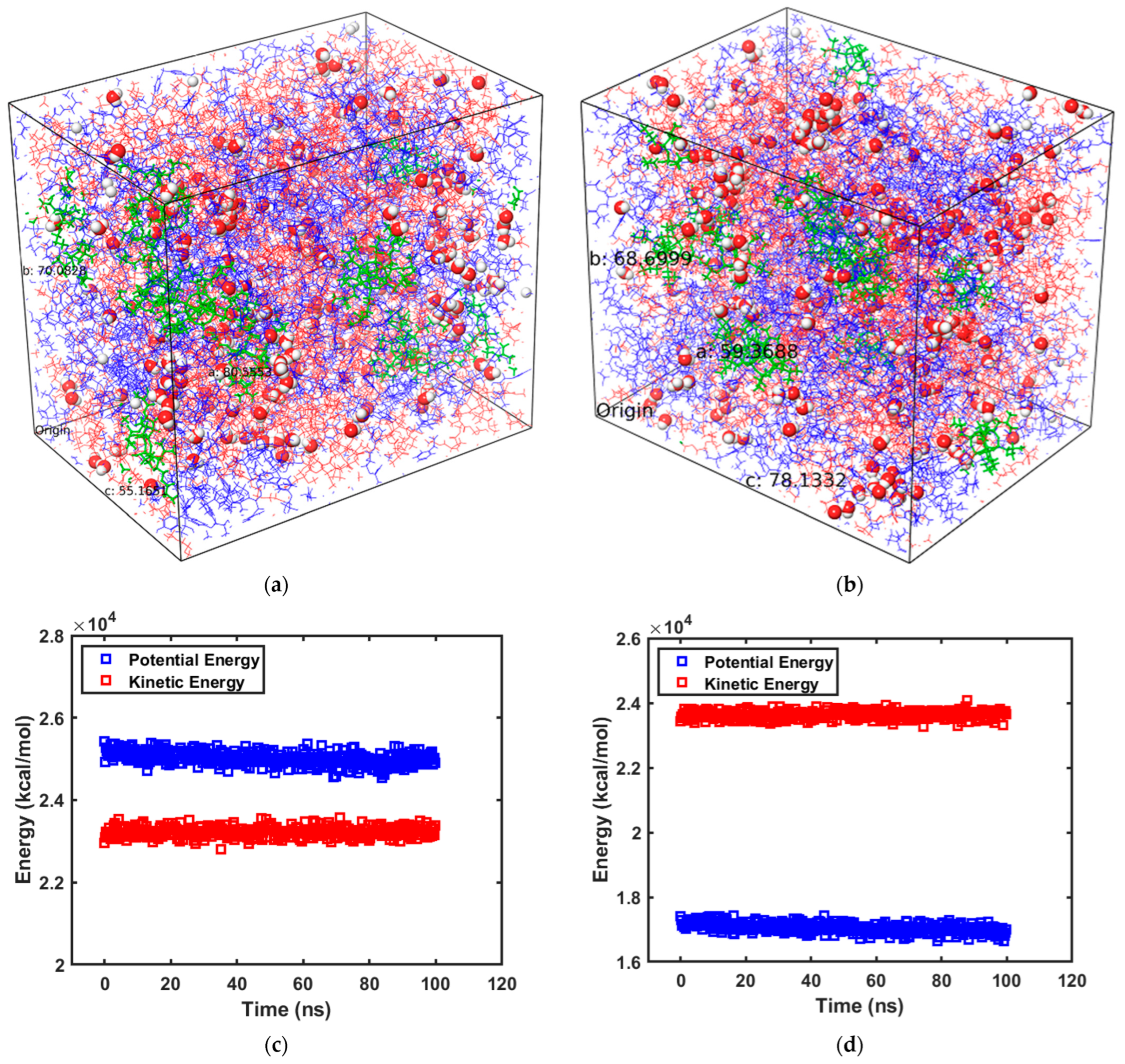
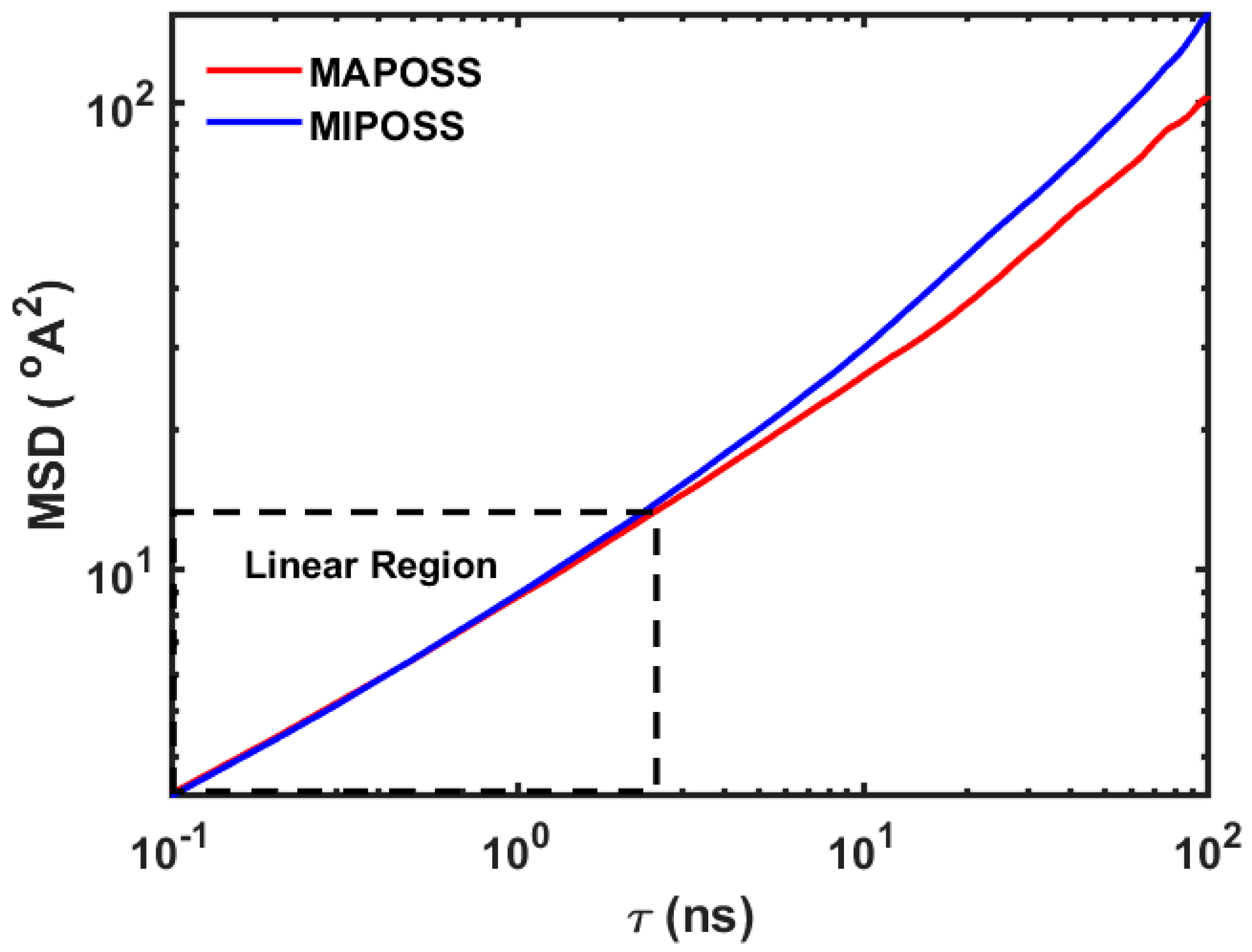
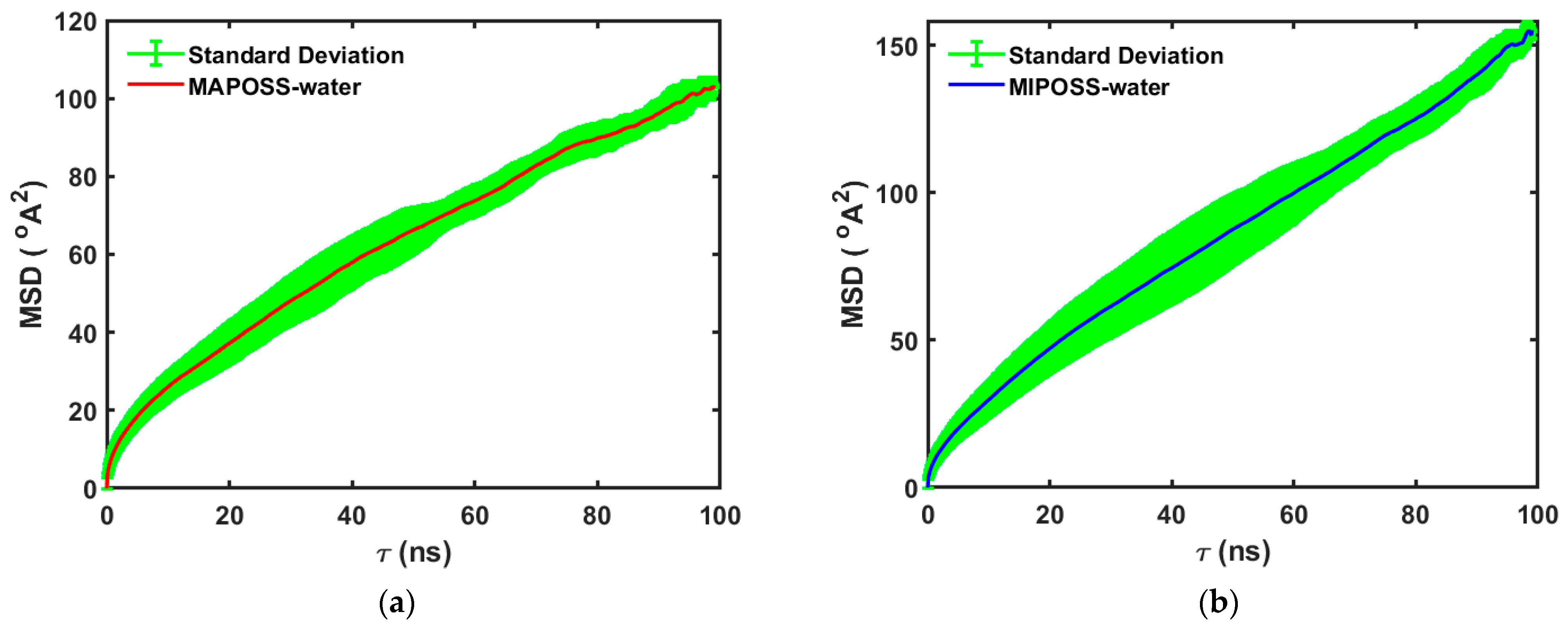
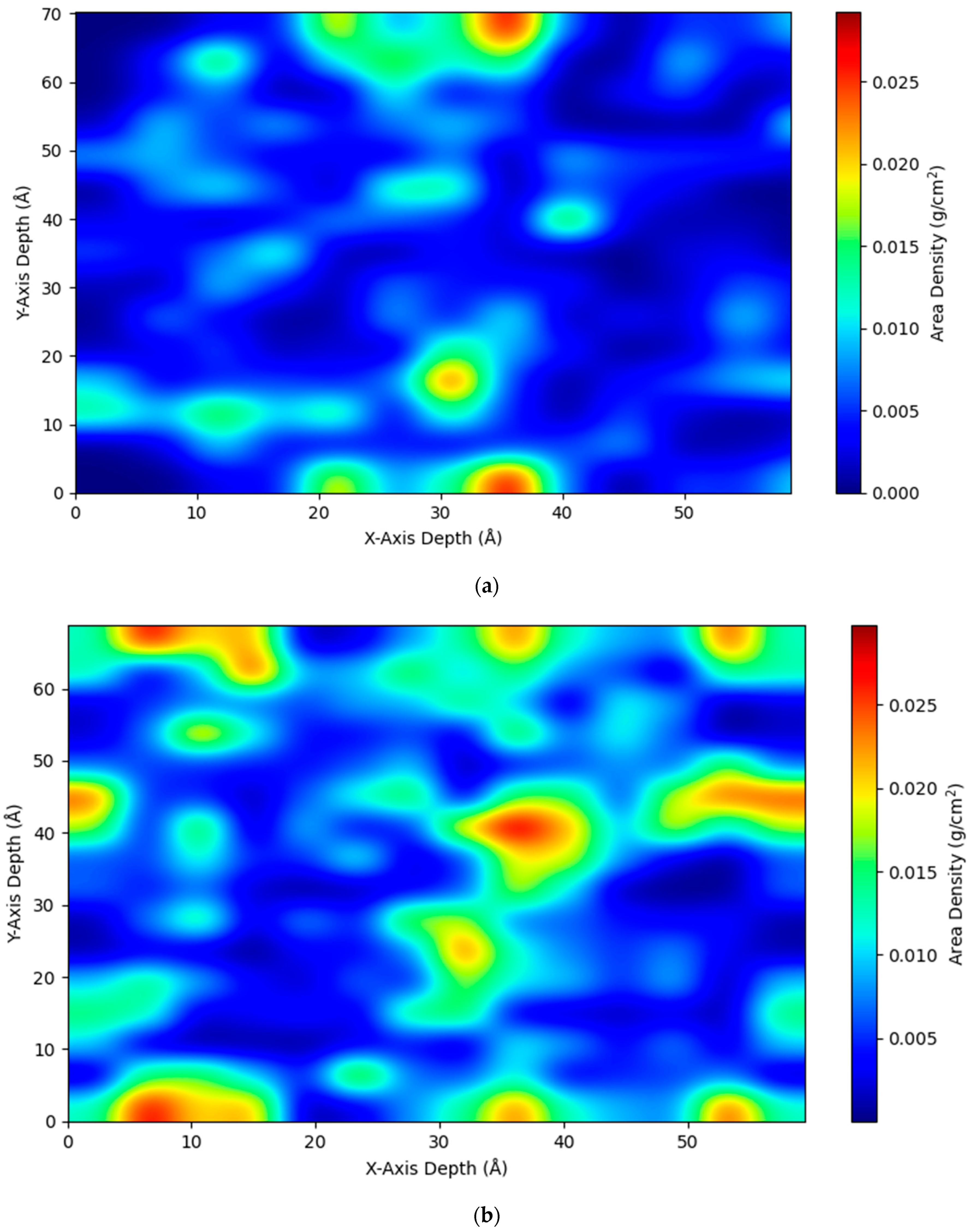
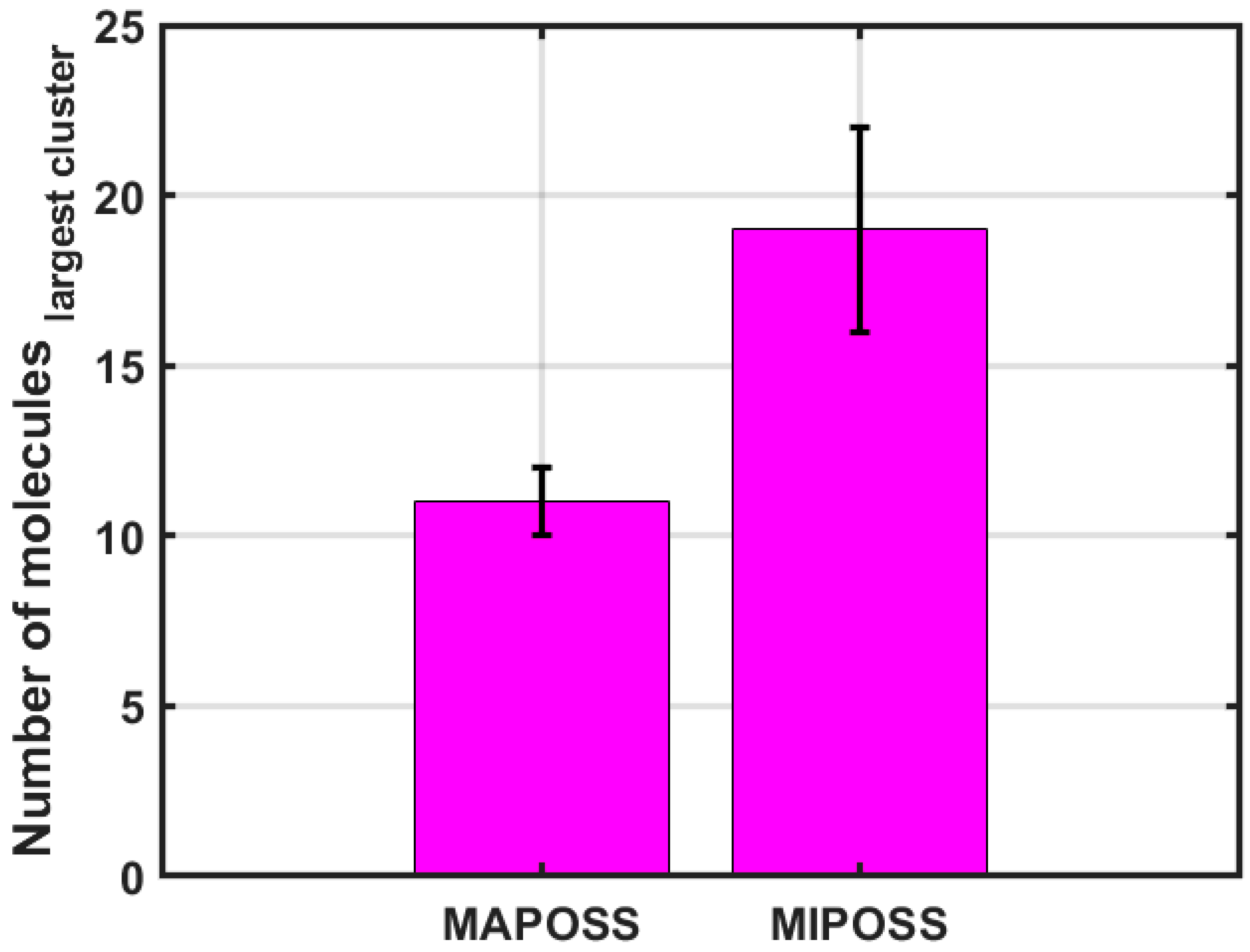
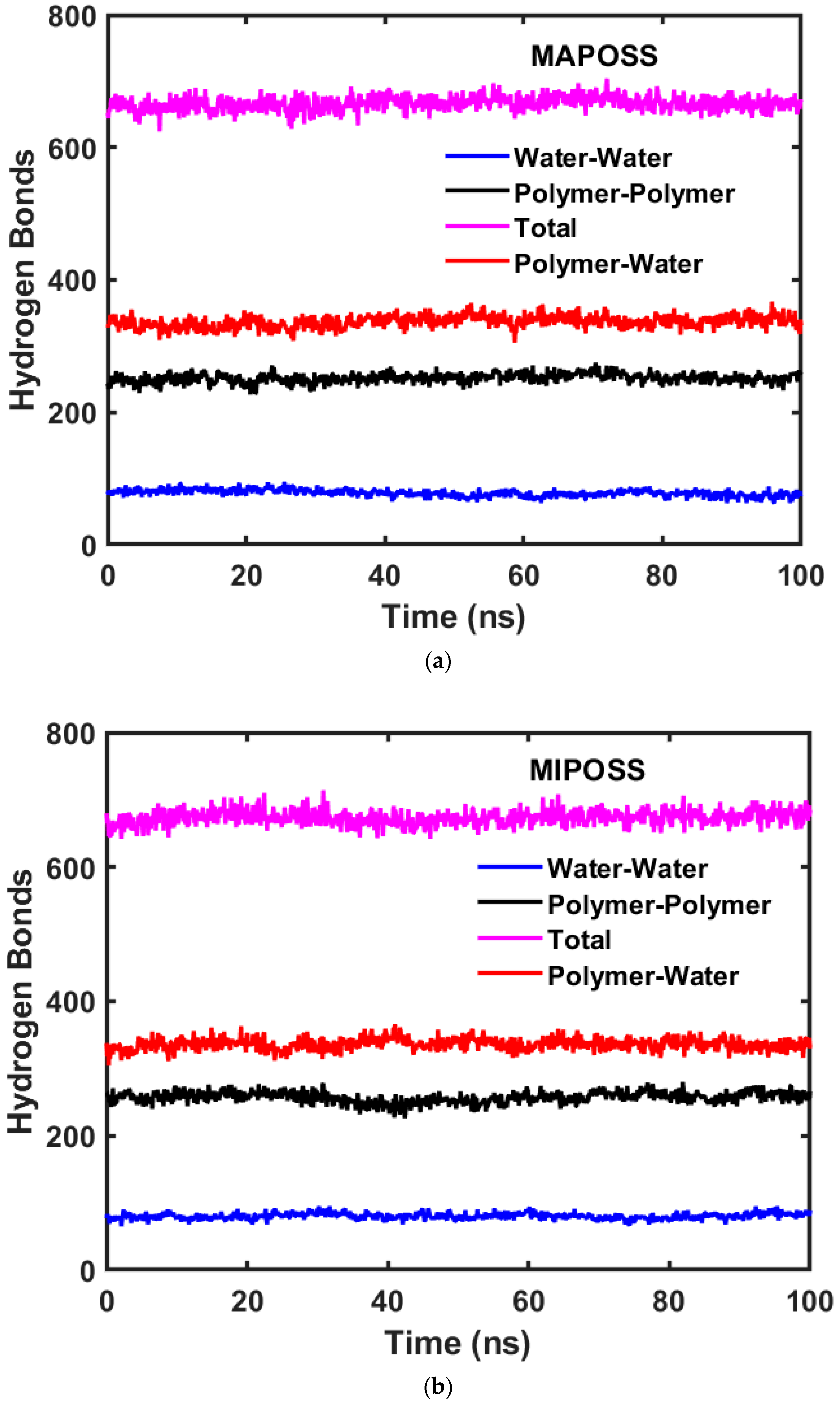
| Composite | BisGMA (wt%) | TEGDMA (wt%) | POSS (wt%) | BisGMA (Number of Molecules) | TEGDMA (Number of Molecules) | POSS (Number of Molecules) |
|---|---|---|---|---|---|---|
| MAPOSS | 47.5 | 47.4 | 5.1 | 199 | 357 | 8 |
| MIPOSS | 47.4 | 47.4 | 5.2 | 202 | 362 | 13 |
| System | Diffusion Coefficient (m2/s) |
|---|---|
| MAPOSS—water | 1.7931 × 10−12 ± 5.3331 × 10−15 |
| MIPOSS—water | 2.5016 × 10−12 ± 9.8694 × 10−15 |
| water—water | 4.3654 × 10−9 ± 2.5966 × 10−13 |
| Type of Interaction | Number of Hydrogen Bonds | |
|---|---|---|
| MAPOSS | MIPOSS | |
| Water–Water | 78 ± 5 | 80 ± 5 |
| Polymer–Polymer | 251 ± 7 | 257 ± 9 |
| Total | 666 ± 11 | 674 ± 11 |
| Polymer–Water | 337 ± 9 | 336 ± 9 |
Disclaimer/Publisher’s Note: The statements, opinions and data contained in all publications are solely those of the individual author(s) and contributor(s) and not of MDPI and/or the editor(s). MDPI and/or the editor(s) disclaim responsibility for any injury to people or property resulting from any ideas, methods, instructions or products referred to in the content. |
© 2023 by the authors. Licensee MDPI, Basel, Switzerland. This article is an open access article distributed under the terms and conditions of the Creative Commons Attribution (CC BY) license (https://creativecommons.org/licenses/by/4.0/).
Share and Cite
Madhuranthakam, C.M.R.; Pandiyan, S.; Chaalal, O.; Elkamel, A. Study of Water Sorption in Methacryl-Based Polyhedral Oligomeric Silsesquioxane (POSS) Dental Composites Using Molecular Dynamics Simulations. Polymers 2023, 15, 4161. https://doi.org/10.3390/polym15204161
Madhuranthakam CMR, Pandiyan S, Chaalal O, Elkamel A. Study of Water Sorption in Methacryl-Based Polyhedral Oligomeric Silsesquioxane (POSS) Dental Composites Using Molecular Dynamics Simulations. Polymers. 2023; 15(20):4161. https://doi.org/10.3390/polym15204161
Chicago/Turabian StyleMadhuranthakam, Chandra Mouli R., Sudharsan Pandiyan, Omar Chaalal, and Ali Elkamel. 2023. "Study of Water Sorption in Methacryl-Based Polyhedral Oligomeric Silsesquioxane (POSS) Dental Composites Using Molecular Dynamics Simulations" Polymers 15, no. 20: 4161. https://doi.org/10.3390/polym15204161
APA StyleMadhuranthakam, C. M. R., Pandiyan, S., Chaalal, O., & Elkamel, A. (2023). Study of Water Sorption in Methacryl-Based Polyhedral Oligomeric Silsesquioxane (POSS) Dental Composites Using Molecular Dynamics Simulations. Polymers, 15(20), 4161. https://doi.org/10.3390/polym15204161










